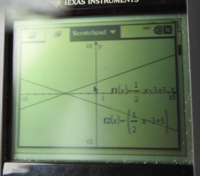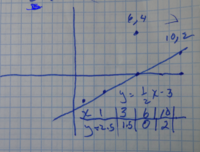allegansveritatem
Full Member
- Joined
- Jan 10, 2018
- Messages
- 962
Here is the problem:
 I
I
I am stuck at c). The only thing I could think of doing is adding a 5 to the 1/2x-3 and then putting a minus sign in front of the function for reflecting it. Here is what thhis looks like in calculator window:

Is this what they want for c)?
I know that y=2 should be a straight horizontal line but...that doesn't seem to have any purchase here.
 I
II am stuck at c). The only thing I could think of doing is adding a 5 to the 1/2x-3 and then putting a minus sign in front of the function for reflecting it. Here is what thhis looks like in calculator window:

Is this what they want for c)?
I know that y=2 should be a straight horizontal line but...that doesn't seem to have any purchase here.


